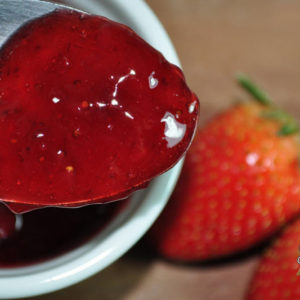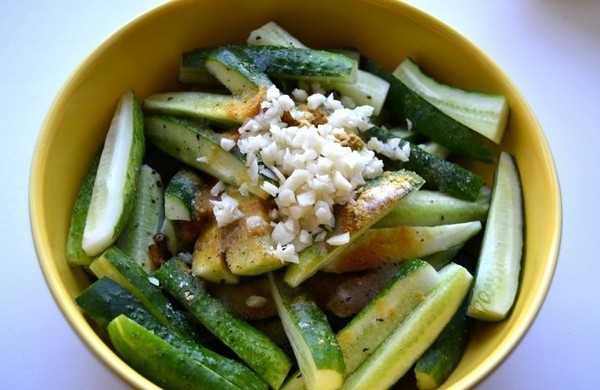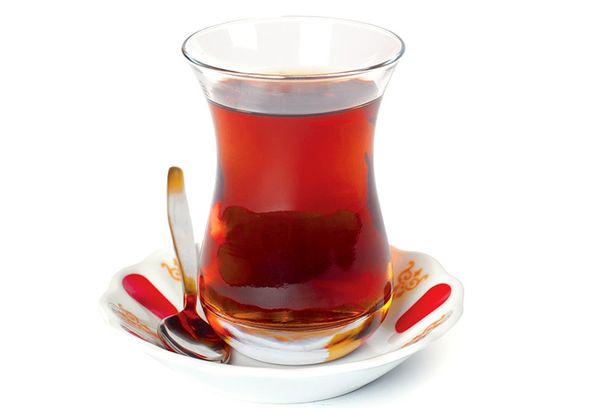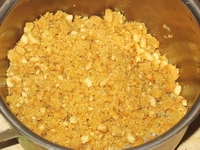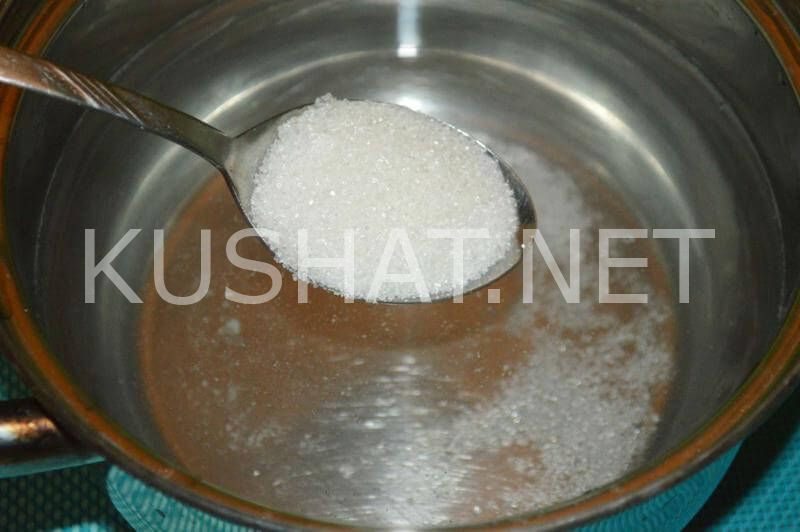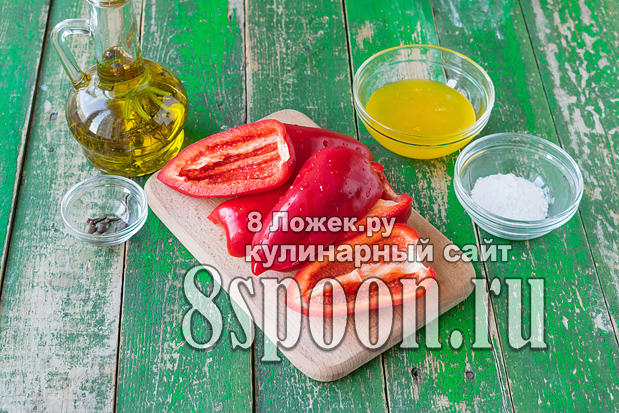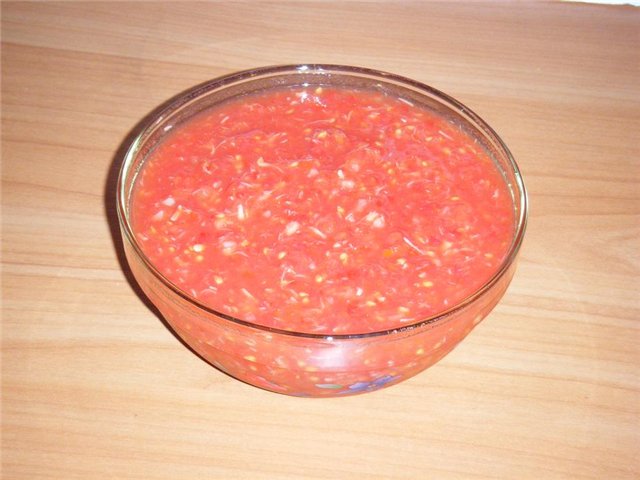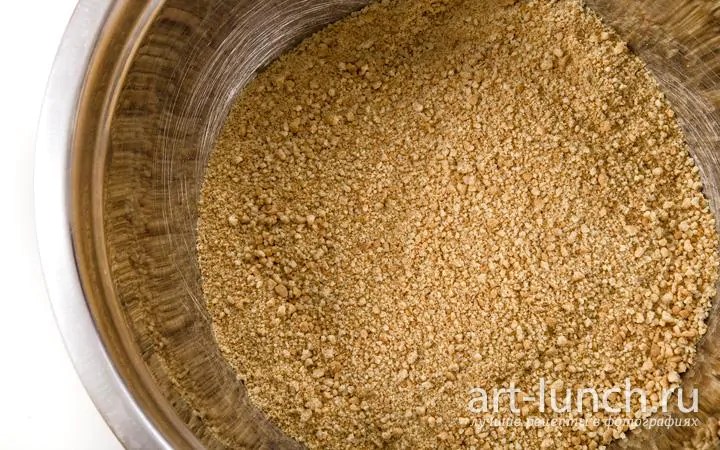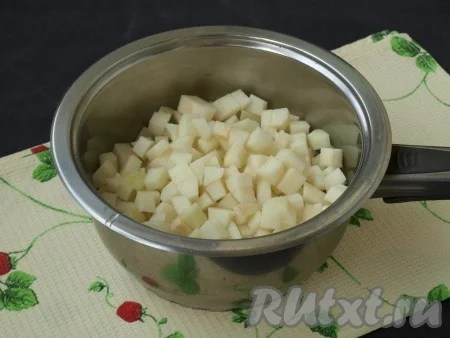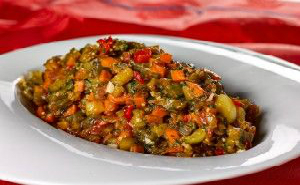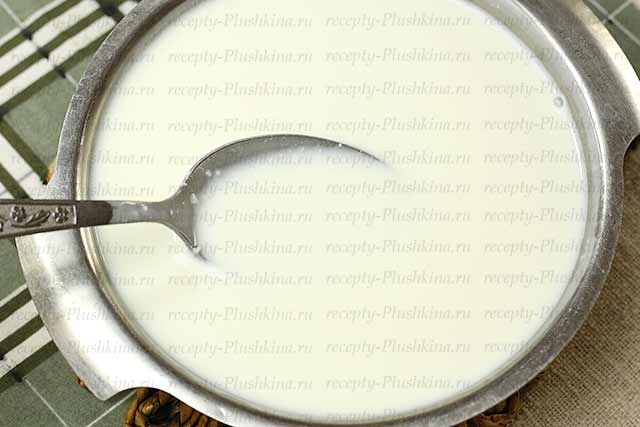How to make horseradish root horseradish. Horseradish Recipes
Horseradish, horseradish, horlloder, "light", "thistle" - these are all variations on the theme of our popular horseradish and tomato snacks. And although dodgy hostesses adapted spicy ingredients (pepper, garlic) for seasoning, the basis of the classic recipe for preparing horseradish should always be real grated horseradish and tomatoes. However, there are many worthy methods that combine horseradish with plums, bell pepper and other additives. Today we will talk about how to prepare horseradish with various ingredients for the winter.
Horseradish with tomatoes and garlic: how to choose products for harvesting?
To make the finished product tasty, healthy, stand as long as possible and not spoil, it is important to use high-quality products.
Tomatoes it is better to take perespevye, but without spoilage. If they are spoiled, the appetizer may ferment before time. If you take tomatoes with greens, then outwardly and to taste the horseradish will be inferior to that made of juicy, dense and ripe fruits. The redder the tomatoes, the brighter the product, the sweeter they are, the more pronounced the taste. The less watery the tomatoes are, the more concentrated the sauce will be. Autumn tomato varieties work great in this recipe; they are also suitable for the time of preparing horseradish, and they are good in density. These are Cream-type varieties that ripen to market ripeness in late August.
Horseradish: you’ll definitely not ruin them. However, if you take sluggish, thin roots, you are tormented to clean and grind them. Find strong, thick, juicy roots, peel them and, for the sake of fidelity, put them briefly in the freezer. How a little harden - get out and twist in a meat grinder, so the process will go much faster. In order not to sob over the meat grinder, put a plastic bag on the pipe at the grate and collect the grated horseradish into it.
Garlic: the larger the heads, the juicier the vegetable. But the smaller they are, the “worse” is garlic.
Salt: it should only be coarsely ground. In principle, there should not be any iodized or finely ground salt in the workpieces, including in horseradish!
The classic recipe for horseradish for the winter
This recipe combines three things - tomatoes, horseradish root and garlic. Horseradish with tomatoes and garlic is the most common recipe, and many do it without adding salt. The result is a spicy spicy sauce or appetizer - whoever calls it what. A distinctive feature of classic horseradish can be called the fact that it should only be raw. Real Siberian horseradish never boiled, was not pasteurized, it was simply stored in a cold cellar. Today, in the absence of a cellar, this sauce can be kept in the refrigerator, in a jar with a nylon cover. If everything is done cleanly, accurately, the correct ratio of salt and garlic is put, the workpiece will not sour and will not disappear.
Mix everything and add salt to taste. Put the workpiece in the refrigerator for half an hour while sterilizing the jars.
Banks should be clean and dry - the latter is also important! While cooking jars, try the horseradish to taste. Maybe too sharp or under salted? Add salt or tomatoes.
To prevent mold from forming inadvertently under the cover, some tricks can be provided. Sprinkle a spoonful of boiled vegetable oil on top. You can also lightly grease the lid of the jar with mustard before closing.
Aspirin horseradish
If you want to get a 100 percent fresh taste of sauce, try horseradish with aspirin. Opponents of acetylsalicylic acid will be horrified at this moment, although the harm from aspirin is attributed only to canned food with heat treatment, and that harm is not too proven so far. In this case, the workpiece will be completely raw.



Everything is done in the same way as in the previous recipe, only an antiseptic is added to the finished mixture - aspirin tablets in the amount of 1 tablet per 1 liter of horseradish. The tablet should be crushed and mixed with other components. Pour into dry cans and close with durable nylon caps or roll up metal.
Horseradish for winter without boiling fermented
There is another interesting and unexpected way to prepare natural horseradish. Its charm is that it contains only tomatoes, garlic, salt and horseradish, and no chemical preservatives in the form of vinegar. Nevertheless, this method allows you to store seasoning even outside the refrigerator, because it can not be acidified - the principle of fermentation lies at the heart of its preparation. This seasoning has a sharper and sour taste, because it contains a fair amount of lactic acid formed in the process of pickling. Sour, spicy, harsh in taste, it is especially good with meat, for which men usually love it.

To prepare the fermented horseradish, we need:
- a bucket of ripe tomatoes (if you need a smaller amount of the finished product, reduce everything proportionally to the desired volume);
- a kilo or half a kilogram of peeled garlic (the more garlic, the sharper the sauce);
- horseradish roots - 400 g;
- bitter pepper - 3-5 pods;
- salt to taste.
Scroll through the meat grinder tomatoes, pass through it and pepper without seeds, horseradish, garlic. Salt to make it tasty. Mix everything, pour into a 12-liter bucket. It is important that there is little space left from the edges of the bucket to the dish under discussion - the seasoning will begin to “play” and foam.
Cover the bucket and leave at room temperature for five days. During this time, a warm tomato with horseradish and other ingredients will begin to ferment. First, bubbles and foam will appear on the surface, then gradually the tomato will rise upward, leaving liquid juice below. Stir occasionally and wait: she should win back her and acquire a sour taste. Seasoning can be considered finished when fermentation stops. This, by the way, can happen sooner or later, depending on the room temperature.
Homemade food preservation
Section:
Harvesting fruits, berries and vegetables
Page 28
AUTUMN PREPARATIONS
Part 9
HORSERADISH
How to cook RUSSIAN DINING HORSE
Siberian Horseradish
Vodka Horseradish
PAGE CONTENT:
22. Horseradish. How to cook a real RUSSIAN DINING HORSE
22. Horseradish
 Horseradish roots have up to 150-250 mg of vitamin C (five times more than in lemons and oranges), up to 7 percent carbohydrates, essential oils, mineral salts, and volatile products. They are eaten as a hot seasoning for cold dishes, salads, as well as fish and meat products.
Horseradish roots have up to 150-250 mg of vitamin C (five times more than in lemons and oranges), up to 7 percent carbohydrates, essential oils, mineral salts, and volatile products. They are eaten as a hot seasoning for cold dishes, salads, as well as fish and meat products.
The horseradish roots are rubbed on a fine grater, seasoned with salt, sugar, (and vinegar in some non-Russian cuisines - see below for an addition to vinegar-horseradish seasoning). Due to the content of essential oil, horseradish in small doses increases appetite and improves intestinal activity.
For laying for storage, the excavated roots of horseradish need to be freed from the ground and cut 1-1.5 cm above the top of the tops and shoots.
In many countries of the world, horseradish is a reliable and tried-and-tested remedy of traditional medicine. It is used as a diuretic for edema and stones in the bladder. With radiculitis, muscle pain, joint pain, a grated root is used as a local irritant. But horseradish, as, by the way, and mustard, should not be kept on the skin for a long time - you can get a severe burn: the active ingredient is allyl mustard oil, but you should not joke with it.
Horseradish has a pronounced antimicrobial effect. It is good to rinse the mouth and throat with the juice diluted with water for inflammatory diseases of the mucous membranes and tonsillitis. Indeed, in addition to phytoncides, horseradish contains lysozyme - a protein with a bactericidal effect, which is also used by official medicine. Pounded in pulp, horseradish root can be used to treat purulent wounds and various ulcers.

Horseradish can be useful as a cosmetic product. A water infusion of its roots is rubbed on the face and hands to remove freckles and age spots. A mask of equal parts of grated horseradish root and sour apple will help reduce facial skin pores.


Label of industrially prepared horseradish.
Russian table horseradish
The main Russian cold seasoning should be considered horseradish, used for all cold and boiled types of fish dishes (jellied, whole, boiled whole fish, red smoked fish (stellate sturgeon), boiled sturgeon), as well as fish pies and kulebyaki, which was also accepted seize with horseradish, in the case when they were consumed cold, the next day, and not with the heat of the heat.
Along with fish dishes, horseradish seasoning was served with cold meat dishes, especially pork. So, horseradish must be consumed with jelly, aspic, cold aspic piglet, aspic from poultry, boiled beef (cold), tongue, beef and pork offal (but not lamb!), And pork head (on Vasiliev day, January 7 - 10), to aspic and cold veal, and later, at the end of the 19th century, to cold roast beef tenderloin, although this dish was English and, strictly speaking, it should be consumed with mustard.
In Russian classical cuisine, horseradish has always been cooked only directly to the table and tried not to leave it for more than one or two days, since it was believed that the horseradish should be peculiar piquantly sharp, and left for a period of more than two days after cooking, it lost its strength.
Moreover, in Russian, horseradish was always cooked without vinegar, which “kills” the horseradish power and gives it its aftertaste and acetic acidity, which is not typical of Russian national dishes.

It’s absolutely not necessary to peel the horseradish so strongly (this is not potato) - you just need to scrape the most dirty places with a knife.
Wash horseradish is undesirable. In extreme cases, you can only rinse briefly with cold water before rubbing.
Vinegar-based horseradish, or the so-called "Polish horseradish", cooked in Belarus, in Volyn (Ukraine) and mainly in Lithuania.
It was from there that the preparation of horseradish on the vinegar basis came for the undemanding, often drunk consumer (who was “just to be sour in the nose”), designed for two-week and even sometimes monthly storage and for long-term transportation.
This type of horseradish seasoning does not give dishes a specific sweet “Russian taste”.
But with the disappearance of home cooking (the shelf life of the cooked Russian table horseradish is no more than 4-6 hours, because it must be cooked shortly before serving), he began to increasingly replace the traditional Russian horseradish seasoning, which was unusually soft, tender the taste along with an extremely strong and unexpected piquancy, making up the greatest charm of this Russian seasoning.
Horseradish (without vinegar!) Played its traditional role in the Russian national feast: on the one hand, purely culinary - made dishes especially attractive in Russian, and on the other hand, specifically feasting, entertaining, as it always gave rise to jokes and fun at the table, to ironic remarks about newcomers or clumsy, dull, inept people (all kind of rootless aliens arrived) who did not understand and did not learn the art of using horseradish as a seasoning, did not grasp what the secret of this use was.
Meanwhile, this secret was extremely simple: it was necessary to use horseradish only after it was bitten off and only slightly chewed (but not swallowed!) Another piece of fish or meat. In such cases, some “dodgers”, with a certain knack, could consume relatively large portions of horseradish quite safely, while their less experienced and inept janitors sometimes jumped in their places and burst into tears (to the deafening laughter of all those present) from the most insignificant, even tiny doses used without knowledge of specifics and traditions.
Such people have always been recognized as newcomers who did not have their own home and strong Russian family roots. Hence, one of the old Russian customs of testing the bride and groom, which consisted in treating them to such dishes where the use of horseradish was mandatory. At the same time, unlucky often received a complete rejection, even if he had other positive qualities.

Horseradish in Russian - freshly grated horseradish root with added sugar and salt to taste.
A very small addition of grated lemon peel or finely chopped green onions is possible.
Vinegar in horseradish is not added in Russian!
Horseradish in Russian is prepared immediately before serving - the shelf life of this horseradish in an open dish is not more than 3-4 hours, in a tightly closed - not more than 6-8 hours
First of all, for horseradish to be “sweet-evil,” you need a solid, high-quality source product. This means that horseradish root must be at least a finger thick, without damage, juicy, strong. External damage can be eliminated by purely mechanical means, cutting out rotten, ulcerated and bruised, cut and contaminated places.
The loss of juicy horseradish by root is a defect that is practically incorrigible, because an attempt to soak horseradish, although it can lead to the restoration of its mechanical elasticity and thereby ease its rubbing on a grater, will inevitably lead to leaching, soaking and juices that give the horseradish root an aroma , and its amazing peculiar piquant "causticity" (in Russian - "anger").
The degree of leaching can be different in each case, but it always affects not only the taste and strength of the finished table horseradish, but also the duration of the preservation of this force in the finished seasoning. As a rule, for more than 3-4 hours, a tasty fortress of soaked horseradish is not preserved, and this explains the introduction of imitators of a “fortress” like vinegar into the finished table horseradish.
Russian table horseradish should be prepared only from high-quality raw materials - as should all Russian dishes.
To do this, you must properly preserve the root after digging in the fall or spring.
Horseradish is stored in a box with sand, laying in rows so that one root never touches the other, and filling each row with clean, sifted sand, free from clay and earth impurities.
Once a week, this box of sand should be slightly watered (sprayed) with water so that the sand is always uniformly slightly moist.
In this way, you can have absolutely fresh, juicy horseradish throughout the year.
How to cook
RUSSIAN DINING HORSE


Russian table horseradish with a small addition of finely chopped green onions.
Russian table horseradish is one of the best seasonings in World culinary. Only absolute instability in storage (no more than 12-16 hours) does not allow him to become one of the most common seasonings, along with mustard, mayonnaise, ketchup and soy sauce. The freshness and lack of vinegar distinguishes Russian table horseradish from horseradish seasonings used in the Baltic States or the Caucasus, including vinegar.
Only on the second or third day, if the horseradish preparation begins to detect a decrease in severity, you can add a little 0.5 percent vinegar to it, but this will not be Russian horseradish, but so-so “crap” (a product ruined by storage).
In Transcaucasia, a stronger 1.5% solution of real homemade wine vinegar is added and, in addition, this horseradish is tinted with beetroot juice. This type of horseradish seasoning is used with the Georgian jelly from the piglet - husbands, while the Russian type of horseradish seasoning is designed for veal or beef jelly, for aspic from poultry, and mainly for dishes of aspic, boiled and hot-smoked fish . It is in these cases that vinegar as a base, roughening horseradish seasoning, and thereby tender fish meat, is completely unsuitable, while sour cream acts both in contrast and in ennobling.
In classical Russian cuisine, horseradish is used not only as a seasoning for a cold, snack table. Such use was mainly entrenched only in the 18th century, and especially in the 19th century, when the snack table began to play a significant role in public and official life, and when it began to intrude more and more into domestic life due to the expansion of the restaurant chain and the spread of vodka. It was in this situation that the culinary, and the functional, auxiliary role of horseradish as a seasoning, acting moderately and soberly, increased. This caused the cheapening and coarsening of various horseradish seasonings by adding sharp components like 3% vinegar solution and cooking on water, without adding sugar and zest. Like, with vodka, and so it goes.
Ancient, Moscow Russian cuisine of the XVI-XVII centuries used horseradish as a seasoning, firstly, always in its truly Russian, "sour" version, as a traditional and indispensable seasoning for fish. And secondly, introduced seasoning from horseradish and into a series of hot dishes to give them piquancy, aroma and a special “Russian taste”. So, horseradish seasoning was already introduced on the table into the potato (unlike the fish soup!), Into various pickles (chicken and meat, from the kidneys), into all kinds of hodgepodge, as well as into gravy dishes from boiled meat and fish for one or two minutes before serving them to the table.
Thus, horseradish as a seasoning was widely used in Russian cuisine and almost daily appeared on the Russian table anyway. With the invention of salads, horseradish seasoning was introduced into raw salads from grated carrots, turnips, rutabaga, radishes and apples, as well as into salads from boiled root vegetables and vinaigrettes as a spicy dressing.

The horseradish seasoning in Russian cuisine was for a long time (until the end of the 18th - beginning of the 19th centuries) absolutely dominant and had not only nutritional, but also great preventive value in the cold Russian climate, since the horseradish in its Russian version retained its bactericidal character and served as improving the taste of dishes, and to prevent scurvy, flu and other colds and infectious diseases of the upper respiratory tract, as well as for the prevention of intestinal diseases.
At the end of the XVIII century, Russian horseradish in daily nutrition was significantly squeezed out (practically remaining only in the high "master's" kitchen) much cheaper and more stable mustard in storage, although it did not have such healing properties. At the same time, Russian cuisine lost significantly, as when replacing, at about the same time, traditional Russian turnips, which were very valuable in nutrition, with potatoes saturated with empty starch, more suitable for nutrition in mild or tropical climates, but not in the Russian cold. (The high content in turnips of its biochemical compounds of sulfur makes it a unique natural immunostimulant, but provided that it is consumed quite often.)
The taste qualities of horseradish as seasonings were so peculiar and attractive that after the Napoleonic Wars they served as an incentive to create some delicate seasonings in German and Austrian cuisine, where they were introduced by cooks of foreign aristocrats who emigrated to Russia from 1789-1813.
But it was in Western Europe that the special properties of horseradish seasonings were distorted, both due to the inability to preserve the natural “anger” of horseradish and to “soften” these seasonings.

Horseradish with beets is more characteristic of Polish and Ukrainian cuisines.
Grated raw beets along with juice are added to horseradish cooked according to any desired recipe.
Beetroot supplement has a purely decorative meaning, as does not change the taste of horseradish.
HORIZON WITH VINEGAR
Peel the roots, thoroughly wash and grate them or pass through a meat grinder. Prepare the marinade fill. Dissolve salt and sugar in water, bring to a boil, add spices, cover and cool to a temperature of 50 ° C, then add vinegar essence and leave for 24 hours. After insisting, filter the filling through gauze and mix thoroughly with horseradish.
Put the prepared seasoning in jars and cork.
For 1 kg of horseradish:
1st method - 40 g of salt, 80 g of sugar, 800 g of water, 40 g of 80% vinegar essence;
2nd method - 20 g of salt, 40 g of sugar, 500 g of water, 0.5 g of cinnamon, 0.5 g of clove, 20 g of vinegar essence;
3rd method - 40 g of salt, 80 g of sugar, 500 g of beetroot juice, 30 g of vinegar essence.
Horseradish Salad with Carrots and Apples
Wash and peel horseradish, carrots and sour apples, grate, then mix, put tightly in jars and pour hot brine. Cover the jars with lids and sterilize on a small fire half-liter - 10-12 minutes, liter - 15 minutes.
Banks immediately roll up and cool.
If used, add sour cream, drain the brine.
For brine - 1 liter of water, 2-3 tbsp. tablespoons of salt, 3-4 tbsp. tablespoons of sugar.
Dried Horseradish Leaves
Thoroughly wash the leaves of horseradish and, after removing the leaf stalks, hang them to dry, then chop and spread on a sheet of paper on a baking sheet. Dry them by stirring in the oven at a temperature of 40-45 ° C for 2-3 hours or under a canopy during the day. Store dried horseradish leaves in glass jars. They can be used for canned vegetables in open jars.
So that the solution in the cucumbers is not cloudy, does not grow moldy, you need to pour a tablespoon of chopped dried horseradish leaves into it, the mold will not appear and the brine will be transparent and tasty all the time.
A tomato in an open jar will not mold if sprinkled with dry horseradish leaves.
DRIED RADIANT ROOTS
Peel the horseradish rhizomes, rinse and cut on a grater with large holes, then dry in a slightly heated oven.
Grind the resulting workpiece in a coffee grinder and store in glass jars in a cool place, use in the same way as dried leaves.
Siberian "CRACKET"

Horseradish is a famous Siberian seasoning.
This is a basic recipe. There are options when they add pepper (both black and red ground, as well as Bulgarian sweet), vinegar, sugar.
In everyday life, this seasoning is also called "Gorloder", "Khrenoder" and even "Cobra"; in culinary, often - “Spark” seasoning.
Ingredients
:
- 3 kg of tomatoes
- 250 g of horseradish
- 250 g of garlic
Cooking
Fresh tomatoes, along with horseradish and garlic, pass through a manual meat grinder. Salt the resulting mass, put in a glass container, close tightly and place in the refrigerator.
Together with ripe red tomatoes, you can use green ones. You can make horseradish from green tomatoes alone, but the best result is when ripe tomatoes make at least 2/5 of the total.
You can use horseradish immediately after cooking, but if you let it stand for a week in the refrigerator, then it will infuse and be tastier.
It can be stored in the refrigerator for a long time. (The more horseradish and garlic taken, the better and longer stored.)
Before serving, you can add a little mayonnaise or thick sour cream to taste. You can add grated apple to taste (preferably Antonovka).
Another recipe "CRANES"
Ingredients
:
- 1 kg of ripe tomatoes,
- 60 g of horseradish,
- 60 g of garlic,
- 3 teaspoons of salt,
- 1 teaspoon of sugar.
Cooking
Scroll tomatoes, horseradish and garlic through a meat grinder. Add salt and sugar and mix well.
Arrange in small jars (no more than 0.5 l) with tight lids.
Keep refrigerated.
Yield: 1.5 L
TIPS
The peel can not be removed from tomatoes, it will not be felt.
Horseradish and everything else is desirable to scroll in a manual meat grinder - it turns out better and noticeably tastier. Or, in the absence of such a thing, get the hell out of scrolling last - it strongly clogs the bars.
Horseradish needs to be taken approximately 10 g more in the expectation that some part will be screwed on and not rolled.
If you need to scroll a large amount of horseradish, then you need to put a plastic bag on the meat grinder, fixing it with an elastic band, otherwise it will greatly corrode your eyes.
In no case do not use "store" canned horseradish.
Garlic can not be passed through a meat grinder, but crushed with garlic press.
For a more acute taste of seasoning per 1 kg of tomatoes, you need to take 100 g of horseradish and garlic.
On the palate of some, even 60 g of horseradish - a lot. Then take 40 g.
The optimal shelf life in the refrigerator at 40 g of horseradish and 60 g of garlic for 2-3 weeks.

Vodka tincture “HUNTED”

If you recall the descriptions of the village lordly life, you will recall numerous descriptions of the wines, tinctures, liquors and vodkas used at the lordly table. In those days, the owners of the estates kept a huge assortment of home-made alcoholic drinks in their cellars. Many of the owners tried to surprise their guests with drinks for all the letters of the alphabet, from a strong anise to an effervescent apple cider.
An honorable place in the list of Russian drinks has always been occupied by vodka tincture “Khrenovukha” - this is a popular name that came from ancient times.
To prepare it, you need to uncork a bottle of vodka (0.5 l) and put a piece of horseradish root weighing 12-15 g inside. We put in the bottle such a volume of the root, at which the liquid level rises flush with the neck. That is, we fill the free space under the cork with one or more pieces of horseradish root.
In addition, you can add (to taste) 1-2 teaspoons of honey.
Close the bottle tightly and place it in a dark place. After a week, the drink will be ready to drink.
Ginger and Garlic tinctures are prepared in the same way - fill the empty space under the cork of a half-liter bottle of vodka with slices of ginger root (weight about 15 g) or slices of garlic (weight about 10 g). Garlic cloves can be cut in half to speed up the infusion process.
We insist in the dark for a week.
After a week, the "drink of the gods" is subject to tasting. The taste should be such that there is no burning sensation in the mouth, and after swallowing the drink, a corresponding pleasant aftertaste should arise. And it’s just such that you don’t have to really have a bite to eat.
Since the taste is individual, it may happen that the “strength” of the tincture (not alcoholic) does not suit you. If the root taste is too strong, add some pure vodka to the tincture so that the taste of the drink returns to normal.
If it turned out that the drink to your taste is “liquid”, add an extra spine to the drink and insist for another week.
So empirically establish their "company" amount (volume) of added roots, providing the best taste.
With the help of such a simple home-made work, you can treat your guests with your “proprietary” tinctures: horseradish, ginger, garlic. And listen to guests praise your excellent drink.
In this case, do not forget about your marginal rate. After all, everyone has their own. Remember: “everything is medicine and everything is poison!” In the use of tinctures, it is important to observe the measure so that our body does not take revenge on diseases.
5 curious facts about horseradish

Concentrated horseradish (high horseradish)
for supplements in cocktails or for medicinal purposes.
1. Horseradish - an aphrodisiac. Actually, horseradish itself is an aphrodisiac, the unique properties of which clever ancestors have known since time immemorial. Tincture on horseradish and honey not only stimulates the appetite, but also gives vitality. If you comply with the norm drunk, of course. When determining your own dose, keep in mind that the tincture is much more sticky than just vodka.
2. Good horseradish does not cause severe burning in the mouth. And the aftertaste from it remains pleasant, long. If, after drinking a glass of horseradish, you immediately want to hammer in its taste by eating something, then you didn’t take into account something in the recipe. Try, experiment, vary with the proportions of horseradish and honey. Many experts in the preparation of crap are inclined to believe that the secret of its preparation lies in the correctly guessed amount of these two products. There is no hangover from the right crap.
3. There are a huge variety of recipes for preparing horseradish tinctures. They often feature ginger, celery root, garlic, dill, mustard ... But in the original real horseradish should consist of alcohol (vodka), horseradish and honey.
4. Add horseradish to cocktails. An excellent option is obtained when tincture is introduced into one of the famous ingredients.
5. Drink horseradish well chilled from piles previously placed in the freezer for several minutes. The most optimal snack for tincture is jelly.
The recipe for a horseradish with honey for cocktails
Ingredients:
Washed, dried and peeled horseradish root is finely chopped.
We put the horseradish strips in a bottle, pour vodka, add spices.
We insist from 6 to 8 days in a dark place.
Filter the tincture, add honey and let it stand for another 1-2 days.
Store in a cool dark place. Storage for more than 6-8 months is undesirable.

Cocktail "Bullshot" (Beat the Bull)
- horseradish, broth, lemon juice, tabasco, celery, salt, pepper.

Horseradish with a cucumber (Belarusian cuisine).
- Favorite drink of Lukashenko for the first breakfast.
Horseradish seasoning recipe can include completely different ingredients. But we decided to tell you about how to make such a product with minimal cash and time costs.
General information
Before telling you how to cook horseradish seasoning, you should tell what kind of ingredient it is.
Horseradish is a perennial herb that belongs to the Cabbage family. Its stems are long and straight. Basal leaves often reach a height of 60 centimeters. It should be noted that they are often used during pickling various vegetables. In addition, the root of the plant is very popular with cooks. He is long and fat. It is actively used as the basis for the preparation of all kinds of seasonings and sauces.
Horseradish root is a table ingredient that can stimulate appetite and improve digestion. In addition, seasonings based on this product well help digest protein foods.
Product properties
Those housewives who regularly make horseradish seasonings for the winter should definitely know all the properties of the mentioned product. In its merits, it is superior to powder. This seasoning easily diversifies any dishes. It is not only spicy, but also very piquant, nutritious and healing.
According to experts, horseradish root contains volatile bactericidal action. In other words, this product is capable of releasing volatile substances or the so-called plant antibiotics that kill all harmful microbes. They protect the human body from various infectious diseases.

In connection with the foregoing, many housewives are very often interested in how to cook horseradish seasoning. It is to this culinary issue that we will devote today's article.
Classical Russian seasoning
How to make horseradish seasoning? There are many answers to this question. However, among the huge number of recipes, there is one classic that every culinary specialist must know. To prepare it, we need:
- fresh horseradish roots - use at will;
- sand sugar and salt - use to taste;
- lemon, or rather juice, squeezed from it - a few small spoons;
- fat sour cream - add to taste and desire (can be replaced with mayonnaise).
Component Processing
As you can see, the presented horseradish seasoning recipe includes a minimum of inexpensive and affordable products. And before you start preparing it, you should carefully process them.
Thus, fresh horseradish roots should be thoroughly brushed with a sharp knife, and then rinsed under a stream of cold running water. Next, the processed product must be grated.
To prevent the horseradish root from exhausting, it is recommended to put each chopped portion into a prepared jar, on the bottom of which cold boiled water should be poured. In this case, the glass container is required to be tightly closed.

Cooking process
After the main ingredient has been processed, it must be mixed with a small amount of water until a thick porridge is obtained. Next, sugar is added to the product. If you additionally use fresh lemon juice or its zest, it is advisable to reduce the amount of cooled boiling water. This is due to the fact that home seasoning should have a thick rather than watery consistency.
How to present correctly
Now you know how to make horseradish seasoning. In addition, I want to tell you about how it should be properly presented to the table. To do this, thick and spicy slurry must be mixed with sour cream or mayonnaise, and then immediately serve to guests along with any dish. As a rule, the strength of this seasoning lasts for 10-13 hours.
How to make horseradish seasoning with tomatoes
Horseradish is the most popular sauce in Russia, which can not only be purchased at the store, but also made independently. For this we need:
- soft ripe tomatoes - about 3 kg;
- fresh horseradish root - 250 g;
- granulated sugar, salt and black pepper - use to taste;
- garlic cloves - about 250 g.
Component Processing
Quite often, Russian housewives harvest horseradish for the winter. It is very pleasant to open vigorous sauce in the winter cold and add it to freshly prepared homemade dumplings. So you can enjoy this seasoning, we decided to present you its detailed recipe.

To begin with, you should process all the ingredients. Tomatoes need to be washed and cut off all the navels, and the horseradish root and garlic should be well peeled.
Sauce making
After the vegetables are prepared, they should be chopped using a meat grinder. As a result, you should get a sharp tomato mass with a pronounced aroma of garlic and horseradish. At the same time, it should have a fairly liquid consistency. Next, to the resulting sauce, it is required to add salt and chopped pepper to taste.
Final stage
As you can see, horseradish for the winter is preparing pretty quickly. After all the ingredients have been mixed, they must be placed in glass jars, closed with lids and immediately refrigerated. Store the finished sauce should be the only way. After all, if you leave it at room temperature, it will very quickly ferment and sour.
A simple recipe for horseradish seasoning
A fairly large number of housewives are simple and then use it as a spicy additive to the main dishes. For this method, we may need:

Cooking method
The presented horseradish seasoning recipe is very popular among those who love. To prepare it, fresh horseradish roots need to be thoroughly washed, then peeled with a sharp knife and grated on a small grater. After that, you can safely do the cooking of the marinade. To do this, dissolve table salt and granulated sugar in strongly boiling water, and then remove from the stove and add. In the future, the resulting marinade must be combined with the grated horseradish root and mixed well.
To preserve this snack, put it in a sterilized glass jar and roll it up well. This seasoning can be added not only to the main dishes, but also to use it for the preparation of various sauces.
Making a delicious beetroot seasoning
Seasoning from horseradish with beets is very tasty and fragrant. To cook it at home, we need:
- large fresh beets - 1 kg;
- fresh horseradish root - 1 kg;
- filtered drinking water - 1 l;
- table vinegar 6% - 200 ml;
- refined oil - 150 ml;
- sand sugar and salt - 50 g each
Ingredient preparation
Before you make a seasoning of horseradish, you should prepare all the ingredients. The roots must be washed and cleaned, and then wiped dry and chopped using a meat grinder. The beets must be rinsed, put in a pan, pour water, boil and cook until completely soft. Next, the vegetable must be cooled, peeled and grated.

Heat treatment
Having prepared the ingredients, you should start preparing fragrant seasoning. For this, drinking water must be poured into a pan, and then boil it, add salt, sugar and ground horseradish roots. In this composition, the ingredients need to be cooked for 23 minutes. In this case, the fire should be minimal.
After the specified time, the ground beets should be laid out on the products and the heat treatment should continue for another 10-14 minutes.
Seasoning
After the seasoning is cooked, it must be removed from the stove, and then add refined oil and apple cider vinegar. After mixing the ingredients with a large spoon, they should be placed hot in sterilized jars and immediately sealed up.
Having cooled the seasoning at room temperature, it must be removed to the pantry or some other cool place where it can be stored for six months. It is recommended to consume such a fragrant and high-calorie snack 1-2 months after immediate seaming.

Serve beetroot seasoning with horseradish can be on any second and first courses. In addition, some housewives often add it to borscht or use it as a snack salad, putting on a thin loaf of bread.
In our country, horseradish is a fairly common plant and is known primarily as an acute supplement to a wide variety of dishes. But this root is quite capable of acting as the main ingredient. For example, a very popular sauce is prepared on its basis - horseradish seasoning, which can spice up many fish and meat snacks.
Horseradish seasoning is a great addition to hot and cold dishes, which will definitely decorate any table
A little about seasoning itself
Horseradish, which is the main component of our seasoning, is a very useful root. It increases appetite, tones the body and activates energy. A few small jars of this sauce can serve you well. And in order to prepare it, you must adhere to a few simple rules.
Cooking basics
- For seasoning, horseradish, which was collected in late autumn, is considered the most suitable.
- Choose large roots whose length is at least 30 cm and a diameter of not more than 6 cm.
- Before cooking, it is advisable to soak the horseradish in cool water and let stand for three to six hours.
- Then we clean the roots, wrap in cling film and send it to the freezer for about an hour.
On a note! These procedures will help prevent the unpleasant sensations that usually occur when chopping horseradish - your eyes will not watery!
- After you have passed the roots through a meat grinder or grated them, you need to add a little lemon juice or vinegar to the mass.
- Next, prepare the prepared horseradish in small jars or plastic containers.
Thus, you will always have the source product at hand, from which at any time you can quickly prepare the next batch of fresh sauce. The following recipes will tell you how to make horseradish seasoning from beginning to end with various additives.
With beetroot juice
To prepare you need to take:
- a kilo of horseradish roots;
- half a liter of beetroot juice;
- 1 tables. a spoon of vinegar essence;
- half a glass of sugar;
- 3 tables. tablespoons of salt.
We prepare the seasoning: thoroughly wash the horseradish roots, peel them and grind them with a meat grinder. We rub the beets on a fine grater, squeeze the crushed mass, add the resulting juice to the horseradish, which we twisted. Then add vinegar, sugar and salt. Mix everything thoroughly. Spread the resulting seasoning in jars and sterilize for 15 minutes if the jar is half-liter, and for 20 minutes we sterilize the liter jar.
With apple
For the recipe for seasoning from horseradish and apples, take the following ingredients:
- a kilo of apples;
- 0.15 kg of horseradish;
- 0.15 kg of garlic;
- 5 ml of vinegar essence;
- 15 g of salt;
- 20 g of sugar.
We stand the roots in cold water for three hours, after which we peel them. We also peel the apples. Grind the prepared ingredients. Free the garlic from the husk and pass through the press.
We combine all prepared products in a large bowl. Add salt, add sugar, pour in vinegar essence and mix well. We spread the seasoning in small clean jars, cover with lids and send to a water bath. We stand for five minutes, after which it is tightly closed and cleaned in a cool place for storage.
With carrots
For the recipe, take:
- 0.15 kg of horseradish;
- 0.3 kg of carrots;
- 5 g of paprika;
- 5 g of white pepper;
- 10 g of salt;
- 5-7 g sugar;
- half a glass of water;
- 55-60 ml of vinegar.
Peel root vegetables and grind them in any convenient way - twist in a meat grinder or rub on a fine grater. Combine everything in a bowl and pour 150 ml of boiling water. Cover with a lid and leave for five minutes.
We introduce vinegar into the mass, add sugar, paprika, pepper and salt.
On a note! If white pepper was not available, then in this recipe it is quite possible to replace it with black!
Mix everything thoroughly and put it into sterilized jars. Tightly close and determine storage in a cool place.
With garlic and tomatoes
For horseradish seasoning with garlic and tomatoes, take:
- 0.2 kg of horseradish;
- 0.2 kg of tomatoes;
- 0.1 kg of garlic;
- 15 g of salt;
- 15 g of sugar;
- 45-50 ml of vinegar;
- 90 ml of vegetable oil.
Blanch the tomatoes in boiling water for 30 seconds, after which we remove the skin from them and pass through a meat grinder. Add sugar to the tomato mass, salt and send to the stove. With a small supply of gas, boil for 20 minutes. About five minutes before cooking, pour the oil and crushed garlic.
We clean the roots, rub on a fine grater and spread in a boiling tomato mass. Add vinegar and immediately after boiling remove from heat. We lay out on sterilized jars and roll up the lids.
"Spark" with chili pepper
For the recipe, take:
- 0.1 kg of roots;
- kilo of tomatoes;
- 10-12 cloves of garlic;
- chili pepper pod;
- a couple of tables. tablespoons of salt.
On a note! Chili is better to clear of seeds, otherwise the seasoning will turn out to be too vigorous!
Mix the ingredients and add crushed garlic. Salt, add sugar. We spread the seasoning on clean banks and cork.
With bell pepper
For the dish you will need:
- 0.1 kg of burning root vegetable;
- 0.3 kg of bell pepper;
- 4-5 cloves of garlic;
- 15 g of sugar;
- 20 g of salt;
- a couple of tables. tablespoons of lemon juice.
My horseradish, clean and peel. Pods of sweet pepper free from seeds, cut the stalk. We twist the products in a meat grinder.
Add crushed garlic to the resulting mass, pour in lemon juice, salt and add sugar. Mix everything and distribute into sterilized jars. We tightly close the lids and determine for storage in a cool place.
With oranges
Horseradish seasoning with orange juice is prepared from such products:
- 0.1 kg of horseradish;
- a couple of oranges;
- 45 ml of dry white wine;
- 2-3 g of salt.
With sour cream
For the recipe, take:
- 0.3 kg of burning roots;
- 200-220 ml of sour cream;
- 30 g of sugar;
- 2-3 g of salt.
We clean the roots and pass through a meat grinder. Salt, add sugar. Mix everything and add sour cream to the mass.
On a note! If you think that the seasoning is too thick, you can dilute it a little with chilled boiled water.
We shift the mass into a jar, close it tightly and put it in the refrigerator for a couple of hours. Since this seasoning is not stored for long, it is advisable to use it quickly - within two days.
Obviously, cooking horseradish seasoning at home is easy. Therefore, do not rush to buy a store product - better, do it yourself. Indeed, you will be fully confident in its quality.
Enjoy your meal!
All materials on the site are presented for informational purposes only. Before using any means, consultation with a doctor is MANDATORY!
Share with friends.
HORSERADISH
Horseradish roots have up to 150-250 mg of vitamin C (five times more than in lemons and oranges), up to 7 percent carbohydrates, essential oils, mineral salts, and volatile products. They are eaten as a hot seasoning for cold dishes, salads, as well as fish and meat products.
The horseradish roots are rubbed on a fine grater, seasoned with salt, sugar, (and vinegar in some non-Russian cuisines - see below for an addition to vinegar-horseradish seasoning). Due to the content of essential oil, horseradish in small doses increases appetite and improves intestinal activity.
For laying for storage, the dug up roots of horseradish need to be freed from the ground and cut 1-1.5 cm above the top of the tops and shoots.
Russian table horseradish
The main Russian cold seasoning should be considered horseradish, used for all cold and boiled types of fish dishes (jellied, whole, boiled whole fish, red smoked fish (stellate sturgeon), boiled sturgeon), as well as fish pies and kulebyaki, which was also accepted seize with horseradish, in the case when they were consumed cold, the next day, and not with the heat of the heat.
Along with fish dishes, horseradish seasoning was served with cold meat dishes, especially pork. So, horseradish must be consumed with jelly, aspic, cold aspic piglet, aspic from poultry, boiled beef (cold), tongue, beef and pork offal (but not lamb!), And pork head (on Vasiliev day, January 7 - 10), to aspic and cold veal, and later, at the end of the 19th century, to cold roast beef tenderloin, although this dish was English and, strictly speaking, it should be consumed with mustard.
In Russian classical cuisine, horseradish has always been cooked only directly to the table and tried not to leave it for more than one or two days, since it was believed that the horseradish should be peculiar piquantly sharp, and left for a period of more than two days after cooking, it lost its strength. Moreover, in Russian, horseradish was always cooked without vinegar, which “kills” the horseradish strength and gives it its aftertaste and acetic acidity, which is not typical of Russian national dishes.
Vinegar-based horseradish, or the so-called "Polish horseradish", cooked in Belarus, in Volyn (Ukraine) and mainly in Lithuania.
It was from there that the preparation of horseradish on the vinegar basis came for the undemanding, often drunk consumer (who was “just to be sour in the nose”), designed for two-week and even sometimes monthly storage and for long-term transportation. This type of horseradish seasoning does not give dishes a specific sweet “Russian taste”, but with the disappearance of home cooking, it began to increasingly replace the traditional Russian horseradish seasoning, which was characterized by an unusually soft, delicate flavor along with an extremely strong and unexpected piquancy, which the greatest charm of this Russian seasoning. Only such horseradish played its traditional role in the national feast: on the one hand, purely culinary - made dishes especially attractive in Russian, and on the other hand, specifically feast, entertaining, as it always gave rise to jokes and fun at the table, ironic remarks about newcomers or awkward, clumsy, inept people (all kind of rootless foreign visitors) who did not understand and did not learn the art of using horseradish as a seasoning, did not grasp what the secret of this use was.
Meanwhile, this secret was extremely simple: it was necessary to use horseradish only after it was bitten off and only slightly chewed (but not swallowed!) Another piece of fish or meat. In such cases, some “dodgers”, with a certain knack, could consume relatively large portions of horseradish quite safely, while their less experienced and inept janitors sometimes jumped in their places and burst into tears (to the deafening laughter of all those present) from the most insignificant, even tiny doses used without knowledge of specifics and traditions. Such people have always been recognized as newcomers who did not have their own home and strong Russian family roots. Hence, one of the old Russian customs of testing the bride and groom, which consisted in treating them to such dishes where the use of horseradish was mandatory. At the same time, unlucky often received a complete rejection, even if he had other positive qualities.
First of all, for horseradish to be “sweet-evil,” you need a solid, high-quality source product. This means that horseradish root must be at least a finger thick, without damage, juicy, strong. External damage can be eliminated by purely mechanical means, cutting out rotten, ulcerated and bruised, cut and contaminated places. The loss of juicy horseradish by root is a defect that is practically incorrigible, because an attempt to soak horseradish, although it can lead to the restoration of its mechanical elasticity and thereby ease its rubbing on a grater, will inevitably lead to leaching, soaking and juices that give the horseradish root an aroma , and its amazing peculiar piquant "causticity" (in Russian - "anger"). The degree of leaching can be different in each case, but it always affects not only the strength of the finished table horseradish, but also the duration of the preservation of this force in the finished seasoning. As a rule, the fortress of soaked horseradish is not preserved for more than a day, and this explains the introduction of imitators of “fortress” like vinegar into the finished table horseradish.
Russian table horseradish should be prepared only from high-quality raw materials - as should all Russian dishes. To do this, you must properly preserve the root after digging in the fall or spring. Horseradish is stored in a box with sand, laying in rows so that one root never touches the other, and filling each row with clean, sifted sand, free from clay and earth impurities. Once a week, this box of sand should be slightly watered (sprayed) with water so that the sand is always uniformly slightly moist. In this way, you can have absolutely fresh, juicy horseradish throughout the year.
- How to cook RUSSIAN DINING HORSE:
1. When preparing table horseradish, the root is cleaned with a knife, but avoid washing by rinsing it, in extreme cases, after cleaning under a stream of cold running water.
2. Then rub on a fine grater, after preparing a jar (glass, porcelain) with cold boiled water poured on its bottom. In this bowl, as the horseradish is rubbed, rubbed portions are constantly being added, preventing them from exhaling in the open air.
3. Then, when the rubbing process is over, a little more water is added to the grated mass until the consistency of a thick porridge, then sweetened with 1 piece of sugar and salted to taste (a pinch of salt).
It is good to add grated lemon peel and lemon juice in addition, while reducing the amount of water accordingly.
The pieces of root remaining during rubbing are also placed in a bowl with ready horseradish by turning them with a spoon so that they are at the bottom.
Such a preparation of horseradish should not be watery, but very thick, the consistency of viscous porridge.
4. Before serving, each tablespoon of such a workpiece is bred with a dessert spoon of sour cream.
It is this composition that is called "Russian table horseradish" (but for no more than 8-12 hours).
Russian table horseradish is one of the best seasonings in World culinary. Only absolute instability in storage (no more than 12-16 hours) does not allow him to become one of the most common seasonings, along with mustard, mayonnaise, ketchup and soy sauce. The freshness and lack of vinegar distinguishes Russian table horseradish from horseradish seasonings used in the Baltic States or the Caucasus, including vinegar.
Only on the second or third day, if the horseradish preparation begins to detect a decrease in severity, you can add a little 0.5 percent vinegar to it, but this will not be Russian horseradish, but so-called “horseradish” (a product damaged by storage).
In Transcaucasia, a stronger 1.5% solution of real homemade wine vinegar is added and, in addition, this horseradish is tinted with beetroot juice. This type of seasoning horseradish is used with the Georgian jelly from the piglet - husbands, while the Russian type of seasoning horseradish is designed for veal or beef jelly, for aspic from poultry and, mainly, for dishes of aspic, boiled and hot-smoked fish . It is in these cases that vinegar as a base, roughening horseradish seasoning, and thereby tender fish meat, is completely unsuitable, while sour cream acts both in contrast and in ennobling.
In classical Russian cuisine, horseradish is used not only as a seasoning for a cold, snack table. Such use was mainly entrenched only in the 18th century, and especially in the 19th century, when the snack table began to play a significant role in public and official life, and when it began to intrude more and more into domestic life due to the expansion of the restaurant chain and the spread of vodka. It was in this situation that the culinary, and the functional, auxiliary role of horseradish as a seasoning, acting moderately and soberly, increased. This caused the cheapening and coarsening of various horseradish seasonings by adding sharp components like 3% vinegar solution and cooking on water, without adding sugar and zest. Like, with vodka, and so it goes.
Ancient, Moscow Russian cuisine of the 16th – 17th centuries used horseradish as a seasoning, firstly, always in its truly Russian, “sour cream” version, as a traditional and indispensable seasoning for fish. And secondly, introduced seasoning from horseradish and into a series of hot dishes to give them piquancy, aroma and a special “Russian taste”. So, horseradish seasoning was already introduced on the table into the potato (unlike the fish soup!), Into various pickles (chicken and meat, from the kidneys), into all kinds of hodgepodge, as well as into gravy dishes from boiled meat and fish for one or two minutes before serving them to the table.
Thus, horseradish as a seasoning was widely used in Russian cuisine and almost daily appeared on the Russian table anyway. With the invention of salads, horseradish seasoning was introduced into raw salads from grated carrots, turnips, rutabaga, radishes and apples, as well as into salads from boiled root vegetables and vinaigrettes as a spicy dressing.
The horseradish seasoning in Russian cuisine was for a long time (until the end of the 18th - beginning of the 19th centuries) absolutely dominant and had not only nutritional, but also great preventive value in the cold Russian climate, since the horseradish in its Russian version retained its bactericidal character and served as improving the taste of dishes, and to prevent scurvy, flu and other colds and infectious diseases of the upper respiratory tract, as well as for the prevention of intestinal diseases.
At the end of the XVIII century, Russian horseradish in daily nutrition was significantly squeezed out (practically remaining only in the high "master's" kitchen) much cheaper and more stable mustard in storage, although it did not have such healing properties. At the same time, Russian cuisine lost significantly, as when replacing, at about the same time, traditional Russian turnips, which were very valuable in nutrition, with potatoes saturated with empty starch, more suitable for nutrition in mild or tropical climates, but not in the Russian cold. (The high content in turnips of its biochemical compounds of sulfur makes it a unique natural immunostimulant, but provided that it is consumed quite often.)
The taste qualities of horseradish as seasonings were so peculiar and attractive that after the Napoleonic Wars they served as an incentive to create some delicate seasonings in German and Austrian cuisine, where they were introduced by cooks of foreign aristocrats who emigrated to Russia from 1789-1813.
But it was in Western Europe that the special properties of horseradish seasonings were distorted, both due to the inability to preserve the natural “anger” of horseradish and to “soften” these seasonings.
HORIZON WITH VINEGAR
Peel the roots, thoroughly wash and grate them or pass through a meat grinder. Prepare the marinade fill. Dissolve salt and sugar in water, bring to a boil, add spices, cover and cool to a temperature of 50 ° C, then add vinegar essence and leave for 24 hours. After insisting, filter the filling through gauze and mix thoroughly with horseradish.
Put the prepared seasoning in jars and cork.
For 1 kg of horseradish:
1st method - 40 g of salt, 80 g of sugar, 800 g of water, 40 g of 80% vinegar essence;
2nd method - 20 g of salt, 40 g of sugar, 500 g of water, 0.5 g of cinnamon, 0.5 g of clove, 20 g of vinegar essence;
3rd method - 40 g of salt, 80 g of sugar, 500 g of beetroot juice, 30 g of vinegar essence.
Horseradish Salad with Carrots and Apples
Wash and peel horseradish, carrots and sour apples, grate, then mix, put tightly in jars and pour hot brine. Cover the cans with lids and sterilize on a small fire half-liter - 10-12 minutes, liter - 15 minutes.
Banks immediately roll up and cool.
If used, add sour cream, drain the brine.
For brine - 1 liter of water, 2-3 tbsp. tablespoons of salt, 3-4 tbsp. tablespoons of sugar.
Dried Horseradish Leaves
Thoroughly wash the leaves of horseradish and, after removing the leaf stalks, hang them to dry, then chop and spread on a sheet of paper on a baking sheet. Dry them by stirring in the oven at a temperature of 40–45 ° С for 2-3 hours or under a canopy during the day. Store dried horseradish leaves in glass jars. They can be used for canned vegetables in open jars.
So that the solution in the cucumbers is not cloudy, does not grow moldy, you need to pour a tablespoon of chopped dried horseradish leaves into it, the mold will not appear and the brine will be transparent and tasty all the time.
A tomato in an open jar will not mold if sprinkled with dry horseradish leaves.
DRIED RADIANT ROOTS
Peel the horseradish rhizomes, rinse and cut on a grater with large holes, then dry in a slightly heated oven.
Grind the resulting workpiece in a coffee grinder and store in glass jars in a cool place, use in the same way as dried leaves.
Siberian "CRACKET"
Horseradish is a famous Siberian seasoning.
This is a basic recipe. There are options when they add pepper (both black and red ground, as well as Bulgarian sweet), vinegar, sugar.
In everyday life, this seasoning is also called "Gorloder", "Khrenoder" and even "Cobra"; in culinary, often - “Spark” seasoning.
Ingredients
:
- 3 kg of tomatoes
- 250 g of horseradish
- 250 g of garlic
Cooking
Fresh tomatoes, along with horseradish and garlic, pass through a manual meat grinder. Salt the resulting mass, put in a glass container, close tightly and place in the refrigerator.
Together with ripe red tomatoes, you can use green ones. You can make horseradish from green tomatoes alone, but the best result is when ripe tomatoes make at least 2/5 of the total.
You can use horseradish immediately after cooking, but if you let it stand for a week in the refrigerator, then it will infuse and be tastier.
It can be stored in the refrigerator for a long time. (The more horseradish and garlic taken, the better and longer stored.)
Before serving, you can add a little mayonnaise or thick sour cream to taste. You can add grated apple to taste (preferably Antonovka).
Another recipe "CRANES"
Ingredients
:
- 1 kg of ripe tomatoes,
- 60 g of horseradish,
- 60 g of garlic,
- 3 teaspoons of salt,
- 1 teaspoon of sugar.
Cooking
Scroll tomatoes, horseradish and garlic through a meat grinder. Add salt and sugar and mix well.
Arrange in small jars (no more than 0.5 l) with tight lids.
Keep refrigerated.
Yield: 1.5 L
TIPS
The peel can not be removed from tomatoes, it will not be felt.
Horseradish and everything else is desirable to scroll in a manual meat grinder - it turns out better and noticeably tastier. Or, in the absence of such a thing, get the hell out of scrolling last - it strongly clogs the bars.
Horseradish needs to be taken approximately 10 g more in the expectation that some part will be screwed on and not rolled.
If you need to scroll a large amount of horseradish, then you need to put a plastic bag on the meat grinder, fixing it with an elastic band, otherwise it will greatly corrode your eyes.
In no case do not use "store" canned horseradish.
Garlic can not be passed through a meat grinder, but crushed with garlic press.
For a more acute taste of seasoning per 1 kg of tomatoes, you need to take 100 g of horseradish and garlic.
On the palate of some, even 60 g of horseradish - a lot. Then take 40 g.
The optimal shelf life in the refrigerator at 40 g of horseradish and 60 g of garlic for 2-3 weeks.

